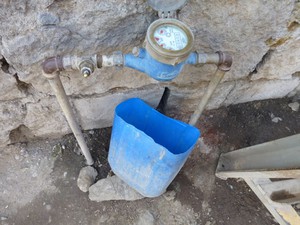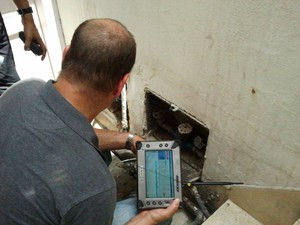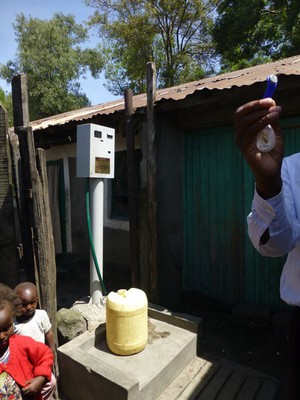The billing process
Water meters are installed at points of water use so that the quantity of water used can be ascertained, and the water user sent a bill for payment. The type of meter in general use has a given flow rate range, which varies with different meters. Usage of water at a higher rate than can be measured by a meter will result in the usage being under-recorded. This means that the bill will be less than it should be. So before installing a water meter, the anticipated rate of water use must be estimated for the given location, and an appropriate meter then installed.
Simple and smart meters
A water meter can be placed below ground level, in a silo with a cover that can be lifted to reveal the meter; above ground, within the compound of the property (Figure 13.1); or on public land outside the property concerned.

Figure 13.1 Water meter inside the compound of a house.
Water meters can be simple, or fitted with automatic meter reading technology. With a simple meter (Figures 13.1 and 13.2), commonly found in Ethiopia, a meter reader employed by the water utility visits the household and physically notes down the meter reading each month to record usage. The meter reader then goes back to the water utility office and passes the reading to the Billing Department staff, who then generate a water bill.

Figure 13.2 A simple water meter.
Where a meter has the facility for automatic meter reading, a meter reader visits the property with a handheld computer or data collection device, as shown in Figure 13.3. The device has an electronic probe. The meter is touched with the probe and a signal from it interrogates the meter and downloads the data needed. Systems are also available by which a meter reader can obtain the required data by walking near the meter, or driving by in a vehicle. The data are downloaded later into a computer that can then automatically and speedily generate a bill.

Figure 13.3 Automated water meter reading.
There are also smart meters (Figure 13.4) that transmit meter readings using wireless technology every hour to the water utility that supplies the water and also to a device in the home or property, so that usage can be monitored. The water bill can be generated rapidly by a computer at the water utility, without a meter reader having to visit the meter. The meter readings are usually monitored by the water utility and a sudden rise in the meter reading can generate a warning that possibly a leak has arisen.

Figure 13.4 A smart water meter.
The different types of water meter have their advantages and disadvantages. The simple meter is robust and inexpensive, while meters with automatic reading facilities and smart meters are costly and sensitive to mishandling. Simple meters, unlike automated and smart meters, require people to take readings and generate a bill, but this gives employment. Automated and smart meters can be used to generate water bills rapidly but require technical expertise to keep them functional.
Prepaid meters
There is no billing process for water purchased from water kiosks because payment is simply by cash. One innovative alternative to this is the use of prepaid meters on public water points, which have been introduced in some parts of South Africa and Kenya (Figure 13.5). With prepaid meters, consumers buy credit in advance, which is registered electronically on a plastic card or token. They then insert the card or token into the meter, which automatically releases water. The cost of the water they have used is deducted from the credit. The advantage of this method is that people can budget for water by topping up their card as and when they can afford to pay. Also, the water point does not have to be managed by a person, and can be open 24 hours a day.

Figure 13.5 A prepaid water meter. The man standing to the right is holding the small blue credit token that is inserted into the meter to obtain water.
In Ethiopia, a pilot trial is underway of a prepayment system for domestic water customers. The householder pays money in advance to the water utility and then uses the water. This enables the household to proactively manage its budget, and simultaneously save time in going to pay the water bill each month. The water utility also makes savings as a meter reader doesn’t have to be sent out to take readings for a bill.